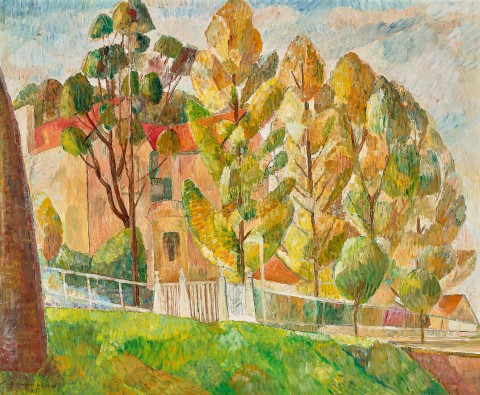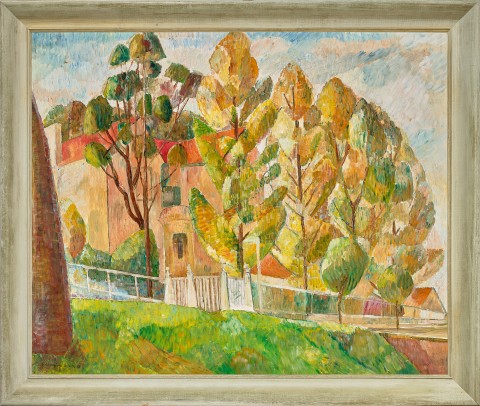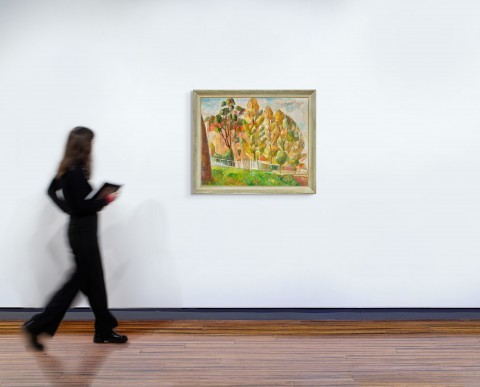(1892 - 1984)
Grace Cossington Smith
House with golden trees (Pink house), 1937
oil on board
Macquarie Galleries, Sydney (label attached verso)
Private collection
Deutscher Fine Art, Melbourne (label attached verso, as 'House with Golden Trees (5 Boomerang Street, Turramurra)')
Private collection, Melbourne, acquired from the above December 1983
Grace Cossington Smith, Macquarie Galleries, Sydney, 21 June – 10 July 1972, cat. 14
House with Trees, 1935 – 39, oil on pulpboard, 54.3 x 64.0 cm, private collection, illus. in James, B., Grace Cossington Smith, Craftsman House, Sydney, 1990, pl. 61
The pink house, c.1935, colour pencil and pencil on paper, 35.0 x 44.4 cm, National Gallery of Australia, Canberra
Grace Cossington Smith never learned how to drive and until her friends started purchasing vehicles and taking her on painting excursions, it was the streets around her home that provided the bulk of inspiration for her art. She lived her entire adult life in the family house ‘Cossington’ located in Turramurra, a leafy suburb in Sydney’s northern suburbs, and her walks would take her some kilometres in all directions. This focused observation, augmented by forensic examination as she sketched her initial studies, resulted in a range of utterly distinctive paintings that cemented her position as one of Australia’s most original artists of the period. In the 1920s, this included works inspired by the local hilly terrain such as Eastern Road, Turramurra, c. 1926 (National Gallery of Australia), and Landscape at Pentecost, 1929 (Art Gallery of South Australia), as well as views from ‘Cossington’ of the tangled bush beyond, best observed in The gully, 1928 (Kerry Stokes Collection, Perth). In the 1930s, the interplay of architectural forms set within local bush gardens increasingly attracted her attention as seen in The winter tree, 1935 (private collection), with the present work, House with golden tress (Pink house), 1937, being a prime example.
Cossington Smith was constantly inventive which is one reason why her images continue to resonate through contemporary eyes. Her particular quest was the depiction of light’s emotional and physical effect on a person, thoughts magnified by her reading (and transcription) of Beatrice Irwin’s pivotal text New science of colour (1915), which ‘expressed the view that the study of colour would lead to more subtle emotions, profound ideas and more quickened spiritual perceptions on a universal level.’1 She was also well aware of the colour-music harmonics practiced by her art-school colleague Roy de Maistre and Roland Wakelin, and of the innovative colour wheels devised by de Maistre and by Margaret Preston in the 1920s.2 These understandings underpin the dissolving forms that Cossington Smith has employed in House with golden tress (Pink house) where the house transitions into the foliage of the bordering trees. With the reduction of their canopies into individual forms, Cossington Smith provides a design counterpoint to the open panes within the fence where each ‘view’ within is treated slightly differently from its companions. Close inspection also reveals her use of pencil not only as underdrawing, but also in the emphatic lines indicating the upright palings of the front gate. Technically, her use of divided brushstrokes points to her reverence of Paul Cézanne rather than the gestural flourishes of van Gogh, with whom she is often considered to be aligned. These ‘firm, separate notes of clear, unworried paint’3 are quintessential to Cossington Smith, who was renowned for ‘never revising her brushstrokes, creat(ing) a matt, almost scumbled effect in (her paintings) which, notwithstanding the impasto, gives in parts the impression of paint having partially sunk into the ground.’4
This residence, ‘Didsbury’ at 5 Boomerang Street, Turramurra, is still notably extant, located about 250 metres from Cossington. Built by the architect Augustus Aley in 1929, ‘Didsbury’ features an ‘entrance porch with a circular drum used to link two wings of the building, approached via a circular forecourt’ opening onto the gate at the corner of Fairlawn Avenue and Boomerang Street.5 Cossington Smith’s initial sketch, The pink house, c. 1935, which became the painting House with Trees, c.1935 (both National Gallery of Australia) focussed on the façade facing Boomerang Street; however, in House with golden tress (Pink house), she has moved down to the entrance corner, a tactic which reveals the artist’s continuing re-examination and progressive analysis of her subjects.
1. Hart, D. (ed.), Grace Cossington Smith, National Gallery of Australia, Canberra, 2005, p. 28
2. Grace Cossington Smith, interviewed by Hazel de Berg, 16 August 1965, in the Hazel de Berg collection, National Library of Australia, DeB 122
3. Grace Cossington Smith, cited in Thomas, D. R., Grace Cossington Smith, Art Gallery of New South Wales, Sydney, 1973, p. 6
4. Edwards, D., Australian Collection Focus: The Lacquer Room, 1935 – 36. Grace Cossington Smith, Art Gallery of New South Wales, Sydney, 1999, non-paginated
5. Ku-ring-gai Council, ‘PLANNING PROPOSAL: To amend the Ku-ring-gai Local Environmental Plan 2015 to list additional Heritage Items and additional Heritage Conservation Area (PP_2015_KURIN_003_00)’, Ku-ring-gai Council (online), p. 162, see: https://www.krg.nsw.gov.au/files/assets/public/v/1/hptrim/information-ma...(accessed 11 July 2025)
ANDREW GAYNOR


